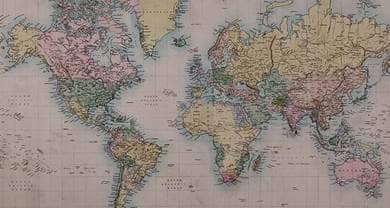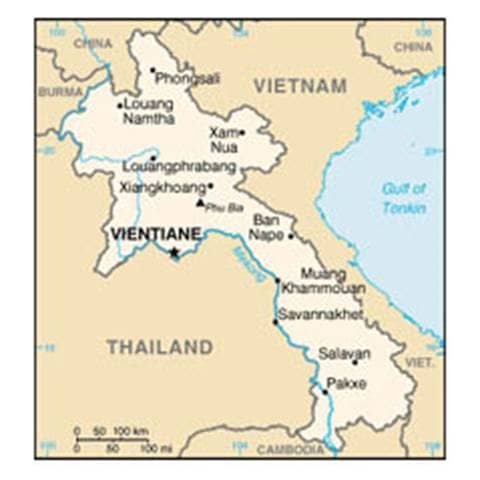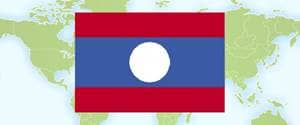- Trending:
- Forgiveness
- |
- Resurrection
- |
- Joy
- |
- Feminism
- |
- Afterlife

RELIGION LIBRARY
Laos

The country has an area of 85,000 square miles and a population of 6.7 million. Theravada Buddhism is the faith of nearly all of the ethnic or "lowland" Lao population, who constitute only 40-50 percent of the overall population of the country. The remainder of the population belongs to at least 48 distinct ethnic minority groups. Most of these ethnic minorities are practitioners of animism and ancestor worship, with beliefs that vary greatly among groups. Animism is predominant among most Sino-Thai groups, such as the Thai Dam and Thai Daeng, as well as among Mon-Khmer and Burmo-Tibetan groups. Even among lowland Lao, many pre-Buddhist animistic beliefs have been incorporated into Theravada Buddhist practice. Roman Catholics and Protestants constitute approximately 2 percent of the population. Other minority religious groups include those practicing the Baha'i Faith, Islam, Mahayana Buddhism, and Confucianism. A very small number of citizens follow no religion.
Theravada Buddhism is by far the most prominent organized religion in the country, with more than 4,000 temples serving as the focus of religious practice and the center of community life in rural areas. In most lowland Lao villages, religious tradition remains strong. Most Buddhist men spend some part of their lives as monks in temples, even if only for a few days. There are approximately 20,000 monks in the country, more than 8,000 of whom have attained the rank of "senior monk," indicating years of study in temples. In addition, more than 400 nuns, many of whom are older widows, reside in temples throughout the country. The Lao Buddhist Fellowship Organization (LBFO) is under the direction of a supreme patriarch who resides in Vientiane and supervises the activities of the LBFO's central office, the Ho Thammasapha.
Although officially incorporated into the dominant Mahanikai School of Buddhist Practice after 1975, the Thammayudh sect of Buddhism still maintains a following in the country. Abbots and monks of several temples, particularly in Vientiane, reportedly follow the Thammayudh School, which places greater emphasis on meditation and discipline.
There are four Mahayana Buddhist temples in Vientiane, two serving the ethnic Vietnamese community and two serving the ethnic Chinese community. Buddhist monks from Vietnam, China, and India have visited these temples freely to conduct services and minister to worshippers. There are at least four large Mahayana Buddhist pagodas in other urban centers and smaller Mahayana temples in villages near the borders of Vietnam and China.
Church officials estimate there are approximately 45,000 Catholics; many are ethnic Vietnamese, concentrated in major urban centers and surrounding areas along the Mekong River in the central and southern regions. The Catholic Church has an established presence in five of the most populous central and southern provinces, and Catholics are generally able to worship openly. No ordained Catholic priests operated in the north, and the Church's activities there remain restricted. There are four bishops, two located in Vientiane Municipality and the others in Thakhek city in Khammouan Province and Pakse city in Champasak Province. One of the bishops oversees the Vientiane Diocese and is responsible for the central part of the country. The second bishop resident in Vientiane is the Bishop of Luang Prabang. He is assigned to the northern part of the country. While the Government did not permit him to take up his post, it permitted him to travel intermittently to visit church congregations in the north including in Luang Prabang, Sayaboury, and Bokeo Provinces. The Catholic Church's property in Luang Prabang was seized after the current Government took power in 1975, and there is no longer a parsonage in that city. An informal Catholic training center in Thakhek prepared a small number of priests to serve the Catholic community. Catholic personnel have also been able to go to Australia and the Philippines for training. Several foreign nuns temporarily serve in the Vientiane Diocese and work with families, the elderly, and younger members.
The Protestant community has grown rapidly over the past decade, and LEC officials estimate that Protestants number as many as 100,000. More than 400 LEC congregations conduct services throughout the country. The LEC maintains properties in the cities of Vientiane, Savannakhet, and Pakse, and LEC officials confirm LEC ownership is recognized in all three locations by the authorities. Many Protestants are members of ethnic Mon-Khmer groups, especially the Khmu in the north and the Brou in Savannakhet and nearby provinces. Protestantism also has expanded rapidly in the Hmong and Yao communities. In urban areas, Protestantism has attracted many lowland Lao followers. Most Protestants are concentrated in Vientiane Municipality, in the provinces of Vientiane, Sayaboury, Luang Prabang, Xiang Khouang, Bolikhamsai, Savannakhet, Champasak, and Attapeu, as well as in the former Saisomboun Special Zone, but smaller congregations are located throughout the country. Seventh-day Adventists number slightly more than 1,200 countrywide, the majority of whom reside in Vientiane Municipality. The group also has congregations in Bokeo, Bolikhamsai, Champasak, Luang Prabang, and Xiang Khouang Provinces.
Christian groups that have some following, but which are not recognized by the Government, include Methodists, Jehovah's Witnesses, Church of Christ, Assemblies of God, Lutherans, The Church of Jesus Christ of Latter-day Saints (Mormons), and Baptists. Official membership numbers are not available.
All three approved Christian groups own properties in Vientiane Municipality. In addition, three informal churches, one each for English-speakers, Korean-speakers, and Chinese-speakers, serve Vientiane's foreign Protestant community.
There are approximately 500 adherents of Islam, the vast majority of whom are foreign permanent residents of South Asian or Cambodian (ethnic Cham) origin. There are two active mosques in Vientiane, where the majority of Muslims reside. The Vientiane mosques follow the Sunni branch of Islam, but both are open to visits by Shi'ites as well. There are also very small numbers of Muslims living in provincial cities, including an estimated 3-4 in Pakse in Champasak Province and 2-3 in Luang Prabang, although there are no mosques in these locations.
Baha'i leaders estimated the Baha'i Faith has 8,500 adherents. A 9-member Baha'i National Spiritual Assembly oversees Baha'i activities including its five centers: two in Vientiane Municipality, one in Vientiane Province, one in Savannakhet Province, and a new center established in Paksane District of Bolikhamsai Province. A small number of Baha'is also live in Khammouane Province and in Pakse City in Champasak Province, and outreach is underway in Oudomsai, Xiang Khouang, Luang Prabang, and Salavan Provinces.
Small groups of followers of Confucianism and Taoism practice their beliefs in the larger cities.
| Population | Population (2009 est.) 6,834,942 |
| Religious Demographics | Buddhist 67%, Christian 1.5%, other and unspecified 31.5% (2005 census) |
| Ethnic Groups | Ethnic Groups Lao 55%, Khmou 11%, Hmong 8%, other (over 100 minor ethnic groups) 26% (2005 census) |
| Languages | Languages Lao (official), French, English, and various ethnic languages |
| Country Flag |  |










